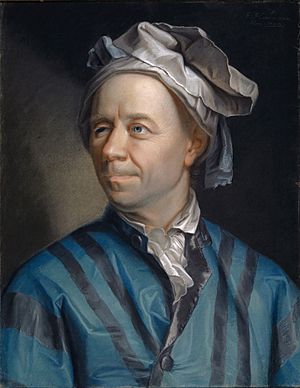Euler's theorem facts for kids
Euler's theorem usually refers to an important idea in mathematics, especially in a branch called number theory. It's named after a brilliant Swiss mathematician named Leonhard Euler.
Euler's theorem helps us understand how numbers behave when we divide them and look at their remainders. This is called modular arithmetic. The theorem is very useful in areas like cryptography, which is the science of secure communication, like sending secret messages.
Contents
Who Was Leonhard Euler?
Leonhard Euler was born in Switzerland in 1707 and became one of the most famous mathematicians in history. He made huge discoveries in many different areas of math and science, including calculus, physics, and astronomy. Even though he lost his eyesight later in life, he continued to do amazing work. He published hundreds of books and papers, and many mathematical ideas, like Euler's theorem, are named after him. He passed away in 1783.
What is a Theorem?
In mathematics, a theorem is a statement that has been proven to be true using logic and other mathematical rules. Think of it like a proven fact in math. Once a theorem is proven, mathematicians can use it as a building block to prove other ideas or solve complex problems. Euler's theorem is one of these important proven facts.
Euler's Totient Theorem Explained
The most common "Euler's theorem" that kids learn about is often called Euler's totient theorem (or Euler's phi theorem). It's about how powers of numbers behave in modular arithmetic.
What is the Totient Function?
Before we get to the theorem, we need to understand something called the totient function, also known as Euler's phi function, written as φ(n).
The totient function φ(n) counts how many positive whole numbers are less than or equal to n and are also coprime to n. Two numbers are coprime if their only common factor is 1. For example:
- φ(1) = 1 (because 1 is coprime to 1)
- φ(6) = 2 (The numbers less than or equal to 6 are 1, 2, 3, 4, 5, 6. The numbers coprime to 6 are 1 and 5. So, there are 2 of them.)
- φ(7) = 6 (Since 7 is a prime number, all numbers from 1 to 6 are coprime to 7.)
What is Modular Arithmetic?
Modular arithmetic is like clock arithmetic. When you say it's 10 o'clock and add 4 hours, it's 2 o'clock, not 14 o'clock. This is because clocks work in "modulo 12."
In modular arithmetic, we are interested in the remainder when one number is divided by another. We write this using the symbol "≡" (which means "is congruent to"). For example:
- 14 ≡ 2 (mod 12) because 14 divided by 12 leaves a remainder of 2.
- 17 ≡ 5 (mod 6) because 17 divided by 6 leaves a remainder of 5.
How Does the Theorem Work?
Euler's totient theorem states that if a and n are two positive whole numbers that are coprime (meaning their greatest common divisor is 1), then:
aφ(n) ≡ 1 (mod n)
Let's break this down:
- a is a number.
- n is another number that a is coprime to.
- φ(n) is Euler's totient function of n.
- aφ(n) means a multiplied by itself φ(n) times.
- ≡ 1 (mod n) means that when you divide aφ(n) by n, the remainder is always 1.
Example: Let a = 3 and n = 10. First, check if 3 and 10 are coprime. Yes, their only common factor is 1. Next, find φ(10). The numbers less than or equal to 10 that are coprime to 10 are 1, 3, 7, 9. So, φ(10) = 4.
According to Euler's theorem, 3φ(10) ≡ 1 (mod 10). This means 34 ≡ 1 (mod 10). Let's calculate 34: 3 × 3 × 3 × 3 = 81. Now, divide 81 by 10: 81 ÷ 10 = 8 with a remainder of 1. So, 81 ≡ 1 (mod 10). The theorem works!
Why is Euler's Theorem Important?
Euler's totient theorem is a very powerful tool in number theory. It's a key idea behind the RSA encryption system, which is one of the most common ways to secure online communications, like when you send emails or shop online. It helps make sure that your information stays private and safe.
The theorem also helps mathematicians understand patterns in numbers and solve problems related to remainders, which might seem simple but are very important in advanced mathematics and computer science.
See also
 In Spanish: Teorema de Euler para niños
In Spanish: Teorema de Euler para niños


